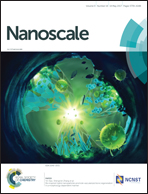Modelling of thermal transport through a nanocellular polymer foam: toward the generation of a new superinsulating material†
Abstract
Superinsulating materials play a pivotal role in achieving the sustainable development of our modern world by improving energy efficiency, and reducing energy consumption and CO2 emission. Nanocellular polymer foams have been considered as a promising superinsulating material, but their development is yet to be achieved. The understanding of thermal transport through the nanocellular foam is crucial for developing this superinsulating material. Herein, we report an accurate mathematical model for the first time to quantitatively estimate thermal transport through the nanocellular polymer foam. This is realized by taking into account the phonon scattering effect, the Knudsen effect and the thin-film interference effect in modeling the thermal transport through solid conduction, gas conduction and thermal radiation, respectively. We demonstrate a quantitative relationship between the cellular structure and the equivalent thermal conductivity and present the optimum cellular structure scope for achieving the superinsulating performance. In particular, the significance of thermal radiation in the nanocellular polymer foam is emphasized. This mathematical model offers a very useful tool for deeply understanding thermal transport through the nanocellular polymer foams, and guiding the development of the new generation of superinsulating materials.



 Please wait while we load your content...
Please wait while we load your content...